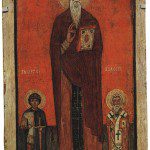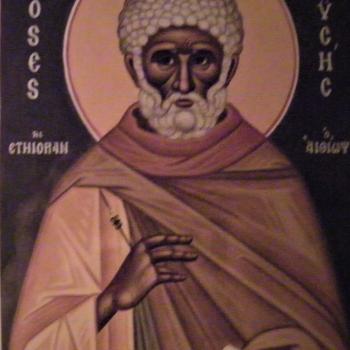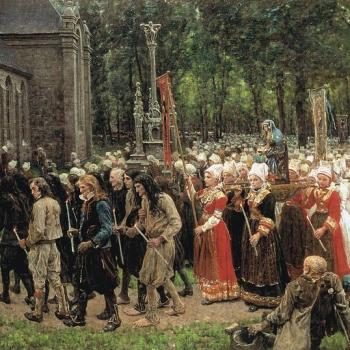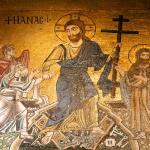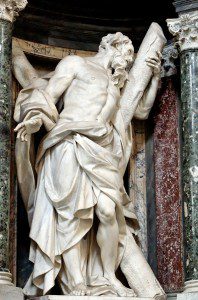
In the Blicking Homily XIX on St. Andrew, we are told the story of St. Matthew’s journey to the city of Mermedonia. The Apostles had cast lots, determining where they would go into the world, and this was one place he was sent. Upon arrival, he is captured, blinded by having his eyes cut out, imprisoned and then prepared to be sacrificed by the city’s cannibalistic inhabitants. While there, God heals Matthew of his blindness as he also reveals to Matthew that he must hold out for thirty days, accepting the indignity, pain and suffering for the sake of Christ, but then at the end of that time, St. Andrew would come to rescue Matthew, those in the prison with him, and evangelize the people in the city.
Near the end of the time Matthew was awaiting rescue, Andrew is given a vision of the plight of Matthew, and in it, he is told he must go and rescue Matthew. Andrew was told he had three days to get there, but the distance seemed too far, and he questioned he was going to do so; the answer was that he would go to sea, find a ship prepared to take him to Mermedonia, and that with God it is possible. Andrew obeyed, got on the ship, and quickly found himself put to a sleep, only to wake up to where he needed to be, realizing in the process, that the ship’s captain had been none other than Jesus himself.
Straightway, Andrew rescues Matthew and those who were imprisoned with Matthew, telling them to exit the city where they will be protected. Andrew, however, has a different mission. He was called to evangelize, but in the process, he too would have to suffer for Christ and put is trust in God that God would save him in the end. A devil, it is said, got the people of the city upset, revealing to them their prisoners had escaped, and Andrew was at fault, whereby the devil told the people to go look for Andrew. While Andrew might have wanted to hide, he was told to boldly go forth in front of the people, and he did so, whereupon the people captured him, severely beating him so that his limbs became disjointed, and then they placed him in their prison, planning to use him as a sacrifice. It is here the story gets interesting, at least in the relationship to the baptizing of pagan traditions. In the jail, in the center, was a pillar with an image on it – who the image represented is not said by the tale, but it was clearly religious in significance. Andrew went to it, and then spoke:
Fear the Lord and the sign of his cross before whom heaven and earth are afraid! Now then, image, do what I command you in the name of my Lord Jesus Christ. Send a great water through your mouth so that all those who are in this city might be destroyed.[2]
What is said to happen next was extraordinary:
When he had said this, the blessed Andrew, quickly the stone image sent a great water through its mouth like saltwater, and it ate at men’s bodies and it killed their children and beasts. And they all wanted to flee from the city. [3]
Then it is said that Andrew had an angel have fire surround the city so no one could flee, while the water continued to rise up to their necks, when at last the people repented and said they would now believe in the Lord Andrew had come to proclaim. The people asked for mercy, and Andrew through his prayers had the water return into the ground. The rest of the story tells how Andrew found he was called to stay with them for a few days, educating them, making sure they had enough catechesis and guidance so that they could continue their new faith once he left.
While the literal reading would suggest that Andrew savagely had the people executed by having flood-like levels of water flow through out of their idol, if it is read allegorically, it is suggestive of baptism, how it washes away and cleanses the one who receives its saving waters, freeing people from the demonic powers which held sway over them. If we read the story as mythic, then those who were executed by Andrew represented the evil forces which held sway over the city, the powers of darkness which are overcome by baptism; the source of that baptism however is a pagan idol, a pagan image, which was able to be used by Andrew to bring forth the cleansing waters in the city and free its inhabitants from its evil ways. Likewise, the church which Andrew built was said to be at the spot where the pillar once stood, showing once again the way Christianity not only employed the best of the pagan tradition, but took it over, and once they were purified from deficiencies, they could be used for the sake of propagating the faith. This legend of St. Andrew therefore is a story of the baptism of a pagan people through the use of its former means of worship and idolatry, and not the mere destruction and elimination of that idolatry before replacing it with the Christian faith.
We can and should heed the lesson of the past today. Christians are not to embrace the bad which they find in the world, but, on the other hand, they are called to embrace people where they are at, and engage them in and with the myths, images, and philosophical understanding they possess today. This means Christians should embrace people in their cultures, and show how their cultures can be used to represent the Christian faith; we do not have to have one culture, one way of imagery, for the Christian way of life. Africans can and should be able to see their heritage is able to baptized tinto Christ, even as those in Asian nations should be able to see Christ as the Eternal Tao leading them to the unity with the Tao, and Native Americans might be able to see relationship between Christ and the Peace Pipe. The key is to promote the truth of faith in all forms possible, to be as Paul said, everything for everyone, a Jew for Jews, and Gentile for the Gentile. To be such a Gentile for the Gentiles includes engaging their traditions and cultures, not rejecting them, because Christ is able to incorporate those traditions into his body the Church.
While we might be used to seeing what Christianity has developed in Europe and confuse it as how Christianity is to imagine itself in the world, the truth is other images, other cultures have much to offer the world, and Christianity truly provides the pillar and ground for them to do so. Moreover, it can be argued, for the sake of the future of Christianity, this is what is necessary to give it a new voice in a world of great change.
[1] Quoted in Bede, Ecclesiastical History. trans. Leo Sherley-Price. Revised by R.E. Latham (London: Penguin Books, 1968). 86-7.
[2] “Blickling Homily XIV: St. Andrew” in Anglo-Saxon Spirituality. trans. Robert Boenig (New York: Paulist Press, 2000), 85.
[3] Ibid., 85
Stay in touch! Like A Little Bit of Nothing on Facebook:
A Little Bit of Nothing


